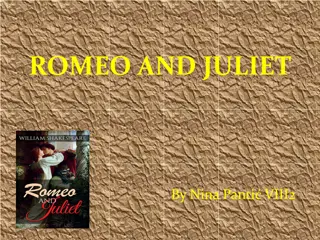Examining Literary Devices in Romeo and Juliet
This review explores key literary devices such as dramatic irony, situational irony, verbal irony, iambic pentameter, simile, metaphor, personification, imagery, and soliloquy in Shakespeare's Romeo and Juliet. Examples from the play illustrate how these devices enhance storytelling and character development, providing a deeper understanding of the text.
Download Presentation

Please find below an Image/Link to download the presentation.
The content on the website is provided AS IS for your information and personal use only. It may not be sold, licensed, or shared on other websites without obtaining consent from the author.If you encounter any issues during the download, it is possible that the publisher has removed the file from their server.
You are allowed to download the files provided on this website for personal or commercial use, subject to the condition that they are used lawfully. All files are the property of their respective owners.
The content on the website is provided AS IS for your information and personal use only. It may not be sold, licensed, or shared on other websites without obtaining consent from the author.
E N D
Presentation Transcript
Final Exam Review English: 2013-2014
Dramatic Irony: -Where the audience knows more than the characters in the story -Example: Act 4 Scene 5 of Romeo and Juliet Juliet is found dead in her bed- they all think she is dead/she is not dead.
Situational Irony: - Involving a situation in which actions have an effect that is opposite to what you think would happen (the outcome is not expected) - Example: In Romeo and Juliet when Romeo tries to make peace between Mercutio and Tybalt but leads to Mercutio's death
Verbal Irony: - In which a person says or writes one thing and means another (says opposite of what they mean) -Example: In Act 3 Scene 5 of Romeo and Juliet when Juliet tells her mother that she would rather marry Romeo (whom she hates) than Paris
Iambic Pentameter: - Meter line in a verse of stressed and unstressed syllables of 5 -Example: if You/ would Put/ the Key/ inSide/ the Lock
Simile: - Comparison of two things using like or as - Example: Brave as a lion or crazy as a fox
Metaphor: - A comparison not using like or as - Example: The snow is a white blanket or you are my sunshine.
Personification: - Giving human characteristics to something nonhuman such as an animal, object, or thing. -Example: The wind whispered through the dry grass or the fire swallowed the entire forest.
Imagery: - Visually descriptive to convey some emotion or give a visual meaning - Example: It was dark and dim in the forest or he whiffed the aroma of brewed coffee.
Soliloquy: - Speaking one s thoughts out loud when by oneself (usually during a play) - Example: In Romeo and Juliet, Juliet speaks to herself on the balcony before Romeo comes to see her O Romeo, Romeo! Wherefore art thou Romeo? Deny thy father and refuse thy name; Or, if thou wilt not, be but sworn my love, And I ll no longer be a Capulet.
Monologue: - When a single character expresses their mental thoughts out loud. - Example: In Romeo and Juliet when Romeo is discussing his feelings for Juliet It is the East, and Juliet is the sun! Arise, fair sun, and kill the envious moon, Who is already sick and pale with grief
Aside: - In which the character speaks to the audience directly - Example: Known as breaking the fourth wall - audience being part of the play or film
Invocation of the Muse: - Some authors use Muses when writing poetry or epics and they typically occur at the beginning of the work and they call for help or inspiration. - Example: From The Odyssey in Book I: Sing to me of the man, Muse, the man of twists and turns driven time and again off course, once he had plundered the hallowed heights of Troy.
MLA Format: Font- Times New Roman Size- 12 pt. font double spaced Margins- 1 inch Indent- First line of each paragraph Heading- top right corner of paper (your last name and page #) -Example: (Celiano 2)
MLA Format Continued: Heading for title page: - Your Name - Teacher s Name - Class/Period - Date
In-Text Citations Examples: 1. Wordsworth stated that Romantic poetry was marked by a "spontaneous overflow of powerful feelings" (263). 2. Romantic poetry is characterized by the "spontaneous overflow of powerful feelings" (Wordsworth 263). 3. Wordsworth extensively explored the role of emotion in the creative process (263).
MLA Works Cited Page: Example- Wordsworth, William. Lyrical Ballads. London: Oxford UP, 1967. Print. Pages 200-263.






















































